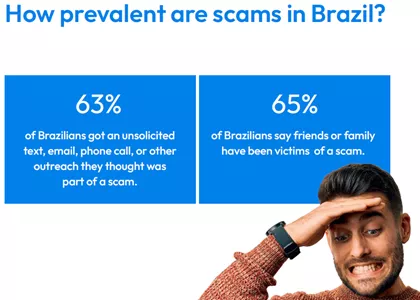Real-Time Payments Rails like FedNow Need Enhanced Fraud Protection
Real-time payments attract real-time fraud, so banks and other financial institutions need the best tools and technology to protect their customers

The U.S. Federal Reserve’s FedNow real-time payment service went live earlier this year, with numerous banks and service providers joining in. This is great news because the real-time payments (RTP) market now has a significant new player, while consumers and businesses will ultimately have another way to move money immediately.
On the other hand, it is troubling news because we know that any RTP rail attracts an active, global community of scammers. These criminals are very good at victimizing users and socially engineering them to use RTP channels to send money as a part of a scam.
In the case of FedNow, the Federal Reserve has largely left payment service providers (PSPs) to figure out fraud management for themselves. This is a significant challenge, but fortunately it is one that professional fraud fighters like me understand well.
Real-Time Payment Fraud Risks Grow Globally
The FedNow launch impacts the entire payments ecosystem. Even though it’s not the first real-time payment system in the world, or even in the U.S. (Zelle, Venmo, and the RTP® network from The Clearing House have been around a while), it is the official public RTP system for the U.S Federal Reserve. Because it’s a bit late to the party, we have a good idea of the deep and murky risk pool FedNow waded into as soon as it went live.
Though it goes by other names, authorized push payment (APP) fraud includes the whole family of real-time payment scams that entice or coerce users into sending real-time payments to thieves. FICO’s 2023 global scams survey uncovered that 51% of consumers worldwide believe their friends or family members have been victims of such real-time payment scams.
Similarly, industry experts are saying that APP fraud is now the #1 fraud risk in the world as 20% of global consumers lost money to some kind of fraud in the past four years, but 27% of the scams that succeeded were real-time payments fraud — more than any other kind. The recently released UK Finance report for the first half of 2023 shows that incidences of APP fraud are up 22% as well, although gross losses have dipped by a mere 1% from the previous year.
Fraud Multiplies with Market Growth
This is not great news for U.S. banks, PSPs, or users, especially because we can expect this problem to scale up just as fast as the real-time payment network does, as we’ve seen in other countries.
For example, by July 2023 more than 470 banks were live on India’s UPI real-time payment rail, which processed nearly 10 billion real-time payment transactions that month. FICO’s global scams survey data showed that 57% of consumers in India – 6% more than the global average – believe their friends or family members have been victims of a real-time payment scam, while 45% use real-time payments for goods or services they never received.

In Brazil, the Pix instant payments platform, which launched late in 2020, processed more than 8 billion transactions in the first quarter and made up 35% of all transactions, exceeding credit and debit cards combined. According to FICO’s survey, 65% of consumers in Brazil believe their friends or family members have been victimized by a real-time payment scam and 22% have made a purchase with a real-time payment and never received the goods.
Even before the FedNow launch, 17% of US consumers told us that they had used a real-time payment to pay for something they never received, and 43% believed friends or family had been similarly scammed. As FedNow expands the real-time payments options in the US — potentially very quickly, like Pix did in Brazil — consumers and banks will need to be wary of fraudsters trying to exploit the new rails.
Learning From Experience
Consumers will be hit with a range of scams that coerce, entice, and otherwise convince people to send money to thieves through real-time payment services. On the bright side, we can learn lessons from the past and our friends across the pond, since the UK has been fighting APP fraud for decades.
One of the most common scams in the UK involves fake investment pitches. These coerce people into using real-time payments to buy anything from timeshares and real estate to securities that don’t exist, and account for “nearly a quarter of all APP losses reported” in the first half of 2023. Thieves use pressure and the immediacy of real-time payments to win. They count on customers not stopping to think before they pay.
Providers Need Partners to Fight Fraud on FedNow, Zelle and Other Rails
The Federal Reserve provides some tools, like its Fraud Classifier, to help identify fraud. The Fed also recommends adding suspicious accounts to watch lists and has indicated that it will provide more fraud tools in the future. But APP fraud won’t stop evolving and PSPs need to protect their customers and themselves immediately.

There’s a significant risk for reputational and customer experience damage if providers can’t manage fraud effectively. FICO’s data shows that 56% of US consumers will complain to their bank if they don’t like how it handles a fraud case, 9% would complain directly to regulators, and another 17% would change banks. But because of their relative newness in the US, real-time payment channels don’t have the same level of fraud defenses that more established channels like credit and debit card do, so the time to act is now.
Tackle RTP Fraud Now
PSPs don’t have to wait until FedNow puts more anti-fraud measures in place or decides on a liability model. They can take action now, using proven tools and methods that have supported PSPs everywhere around the globe as they navigate the rapid growth of RTP adoption and the scams that come with it. Some of the best ways to protect consumers include:
- Scams detection: US consumers don’t have the same liability protection for authorized real-time payments that they do for unauthorized transactions. And once a payment is sent, there’s no effective way to cancel or retrieve it. So, detecting a scam before it happens is necessary for defense. FICO’s award-winning scam model was developed specifically to help detect the events that signal a real-time payment scam and let PSPs and customers take actions to prevent it.
- Scams workflows: One of the challenges any PSP will face with real-time payment fraud is taking the right action or applying the right intervention for an authorized vs an unauthorized payment. Sorting out various types of fraud from each other is a challenge. How different types of fraud (e.g., unauthorized transactions or authorized push payments) are handled once detected is crucial to prevention, follow up, and compliance — now and in the future as FedNow rules evolve further. Having distinct and separate workflows based on fraud type can help improve customer experience while reducing false positives.
- Personalized communications: PSPs need to be able to communicate with customers in real time via their preferred channels to stop scam payments. Highly personalized, multi-channel, multi-touch customer communications that are informed by the customer’s real experience — their transaction and the likely type of scam — are crucial. This is not only to add some sensible friction and warn customers when they’re being scammed, but also to satisfy customers’ desire for better fraud management - 64% of US consumers say they’d like their banks to do fraud detection better.
- Real-time notifications: Customers should be able to customize real-time notifications that inform them of any activity that’s hitting their accounts — debit, credit, banking, real-time payment. One of the best ways for consumers to protect themselves is to set up notifications that tell them if a new device has accessed their account; if any funds have moved in or out; if any charges, payments, or even checks are pending. With more awareness of their transactions, customers are better equipped to notice a scam, account hack, or other fraud before it succeeds.
There is no time like the present to take the steps necessary to defend real-time payment channels from the kind of authorized and unauthorized payment fraud that’s been seen — and managed by solutions provided by FICO —in more mature real-time payment markets worldwide.
How FICO Helps Fight RTP Payments Fraud and Scams
- Learn about FICO’s innovations in fraud protection technology
- Discover the impact of real-time customer communications to stop fraud
- Explore FICO’s award winning retail banking model with scam detection score
- Read the FICO 2023 Scams Impact Survey
For more of my latest thoughts on the evolution of payments, fraud, and FICO’s entire family of software solutions, follow me on LinkedIn.
Popular Posts

Business and IT Alignment is Critical to Your AI Success
These are the five pillars that can unite business and IT goals and convert artificial intelligence into measurable value — fast
Read more
FICO® Score 10T Decisively Beats VantageScore 4.0 on Predictability
An analysis by FICO data scientists has found that FICO Score 10T significantly outperforms VantageScore 4.0 in mortgage origination predictive power.
Read more
Average U.S. FICO Score at 717 as More Consumers Face Financial Headwinds
Outlier or Start of a New Credit Score Trend?
Read moreTake the next step
Connect with FICO for answers to all your product and solution questions. Interested in becoming a business partner? Contact us to learn more. We look forward to hearing from you.
